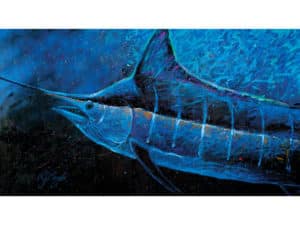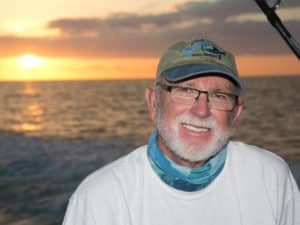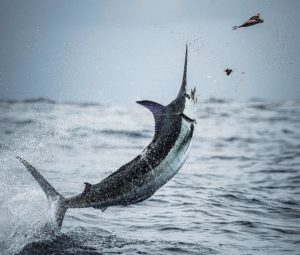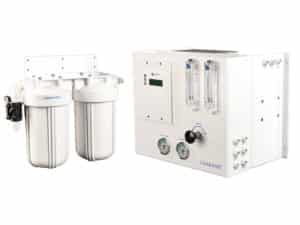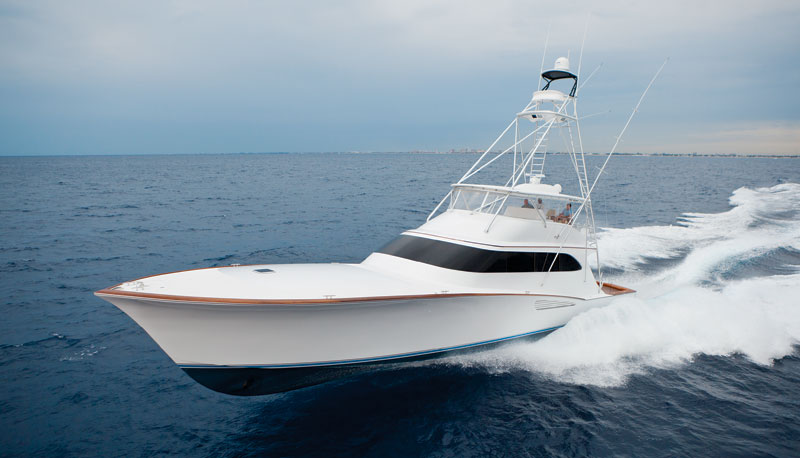
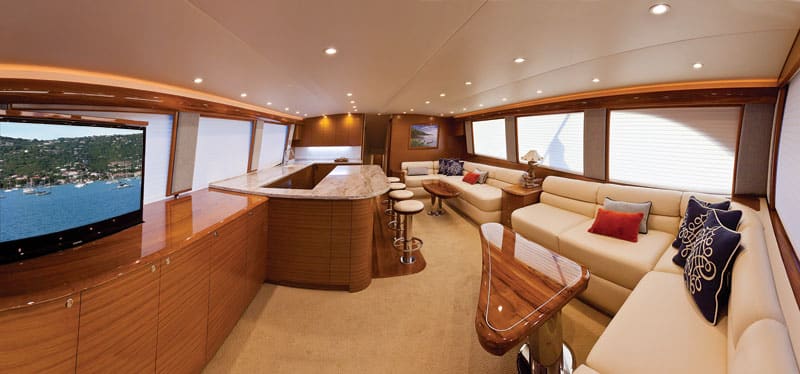
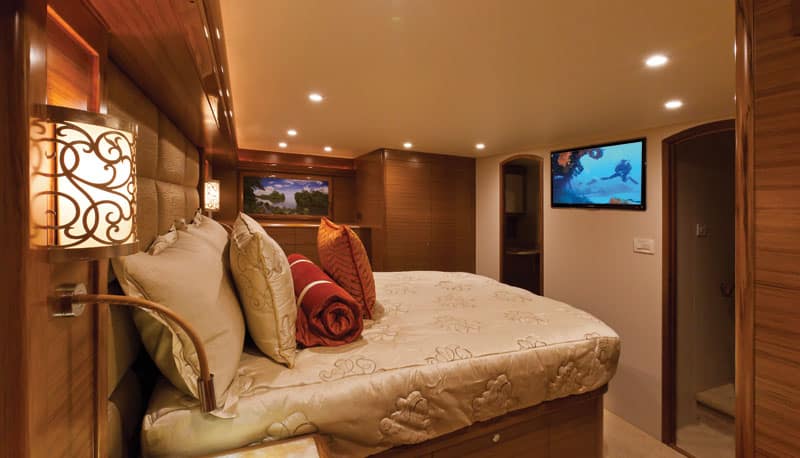
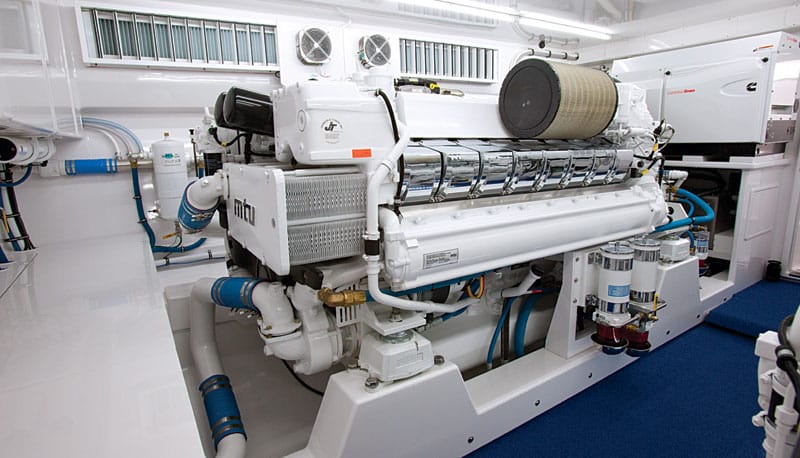
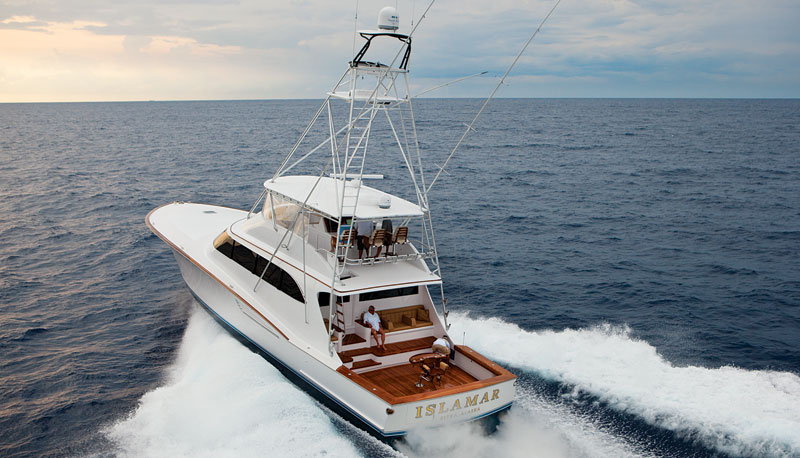

Like 40 is the new 30 when it comes to age, the custom 80-foot sport-fisher of today is really the new 60-footer. I’m sure I’m not the first person to say this, but when I started fishing more than 30 years ago, I don’t believe anyone could have guessed that you would ever be able to successfully fish out of an 80-foot boat. Since then, technology and design have come a long way, and these days it’s not uncommon to find yourself fishing alongside some very competitive crews in boats longer than 80 feet on a regular basis. So when I was asked to do a review of the just-splashed 80 Weaver hull No. 21, I couldn’t wait to get behind the controls and see what she could do.
First Impressions
I met up with the boat’s owners, Mr. and Mrs. Donato, and their captain and builder, Jim Weaver, on the dock in West Palm Beach, Florida, where the boat was tied up. We also brought along famed photographer Scott Kerrigan, but he wasn’t traveling on board; he would be taking to the air to capture the action from above in a chase helicopter.
When I walked up to the boat, a couple of details immediately caught my eye; first, the full custom tower and four-spreader hydraulic Rupp riggers share a matching satin anodizing from Palm Beach Towers, rather than the standard high-gloss anodizing or brushed finish seen on most boats. It looked terrific. Second, the custom helm chairs and the fighting chair, with a thicker than usual rocket launcher from Release Marine, really stood out as well. The boat looked very nice, but it didn’t look like an 80-footer! If someone hadn’t told me that this boat was 80 feet long, I would have guessed it was a 70-footer. Her narrow beam and her beautifully sleek lines do a great job of camouflaging her length — she did not have the unwieldy look of most 80-footers.
Interior
Jim Weaver walked up just minutes after me, and we jumped in the cockpit. Just as I was about to put my shoes in the beautiful Release Marine teak step box, Mrs. Donato opened the automatic sliding door to quickly introduce herself and to inform me that that was not the place for shoes. “We have a place for everything on this boat, and the shoes go in the second step going up to the door,” she said before inviting me into the salon for the tour.
As I entered the salon, Mrs. Donato explained that she and her husband have a large family and that the five-stateroom, five-head layout of the boat was to accommodate the family and crew on their many extended trips to the Caribbean and Central and South America.
On the starboard side to the aft sits a massive L-shaped sofa, and there’s a large U-shaped dinette forward of that. To port aft you’ll find the large entertainment center with a pop-up undercounter flat-screen TV. Forward of the entertainment center, a bar runs more than half the length of the salon, with the four bar stools running almost down the centerline of the salon. You could easily sit 12 or 15 people comfortably in this salon.
The galley comes fully equipped with three Sub-Zero refrigerators, a large oven, a microwave and a dishwasher, all neatly under the counter. Two large stovetops with four burners also hide nicely under the countertops when they’re not in use.
There’s more than enough cabinet space for everything you need in this full-service galley, which was built to accommodate groups. As you move forward of the galley into the companionway, before going down the steps you’ll find two utility rooms, one to port and one to starboard. The room to port sports a wine cooler, two Sub-Zero freezers, more electronics and storage, and a built-in humidor for Mr. Donato’s cigars. The starboard door hides the laundry room, which is complete with a full-size washer and dryer and a custom fold-out ironing board and hanging rack to air dry clothes. And there’s even more storage.
Down Below
Once down the companionway steps, you’ll find two very roomy VIP staterooms, one to port and one all the way forward, and two crew staterooms on the starboard side.
If you make an immediate hard-right U-turn at the bottom of the stairs and then proceed aft down another set of stairs, you’ll enter the full-beam master stateroom.
I decided to go straight to the bow and start in the first of the VIP staterooms and save the master for last. The two VIPs almost mirror each other. Both are very spacious and comfortable and come equipped with in-suite baths. The starboard side holds what I would call the guest/crew rooms. These rooms also come with full heads, but the forward stateroom comes with two under and over bunks to sleep four, and the head just aft of this stateroom could be used as a day head.
The captain’s stateroom is just aft of the crew’s head, but it also has an under-over bunk, in case there’s an extra guest, and a full in-suite head.
Last but not least, I took the short jog down the steps to the master stateroom. This is definitely where you can see the difference between a 60- and an 80-footer. You couldn’t ask for a better place to sleep for the ride out to the fishing grounds in the morning.
On the port and starboard sides of the room, you’ll find a pair of built-in his-and-hers dressers, along with stand-up closets — each with its own built-in safe. The master also boasts an extremely large in-suite head with an extra-large shower.
Performance
We ran a little late going over the beautiful interior, but it was well worth it. Kerrigan and the helicopter were coming in fast, so we needed to shove off, and as we pulled out of the slip, the small black helicopter hovered right overhead. Once at the inlet, the captain throttled up. The twin 2,400-horsepower MTU motors jumped the big girl (110,000 pounds dry weight) up onto plane easily. At 1,650 we ran at 30 knots and burned only 105 gallons per hour — not bad for an 80-footer with 600 gallons of fuel and 100 gallons of water on board. She was also carrying all of their fishing gear, a few spare parts and enough personal items for a few days.
The wind blew out of the south-southwest at about 15 knots, pushing the waves to about 3 to 5 feet inshore.
As we got farther out into the Gulf Stream, the swell quickly grew to a sporty 4 to 6 feet. We ran out to the southeast, as if headed to the Bahamas, for about five miles before starting a big, slow circle to the north. I noticed that at any angle we ran to the sea, we could not get water on the bridge.
While we were still offshore, it was time to see how a boat of this size and horsepower would maneuver in a fishing situation. She trolled nice, clean and stable in all directions. I then asked the captain to back up into the sea to get an idea of how much water would come over the stern. We made 6 knots backing into the Gulf Steam with barely any water coming over the transom.
Since the current was cooking strong, I requested that the captain back into the trough, in order to get a better idea of the boat’s speed in reverse. We hit 8 to 9 knots at just 1,200 rpm before getting water on the covering boards. The boat’s horsepower and 10.5-degree deadrise provide plenty of speed for chasing billfish going backward, but all boats go faster pointy end first, fellas! And all 600 gallons of fuel was in the stern tank. If there had been fuel in the bow tank, I imagine you could get even more speed in reverse, with even less water coming over the transom.
Then it was time for the all-important spin test. With the wheel hard over and no more than 1,200 rpm, she spun around nicely — not light-tackle, world-record chasing speed, but just as good as any 60-foot production boat out there.
As we made our way back to the inlet in a quartering sea, the captain put her to the pins. We hit 44 knots at 2,500 rpm, burning 248 gallons without a full load. With a little more prop work, the boat will probably hit 45 knots in the near future.
Engine Room
Once we tied up back at the dock, I headed down to the engine room and, to no surprise, found a well-organized and nicely laid out space, just like the rest of the boat. Every inch of this vessel is faired and painted. Whether under the decks or under the gunwales, every surface is flawless and shines with high-gloss paint.
I stood down in that engine room talking to Jim Weaver for about 10 to 15 minutes as he explained his building process. (To enhance the boat’s structural integrity, he adds extra stringers forward of the engine room and adds more thickness to the hull laminates between the stringers from the aft bulkhead to the transom, since this is where the shaft tubes, struts and rudders mount.) During that entire conversation, I was oblivious to the fact that we were standing next to a pair of huge engines that had just been running for an hour! The ventilation system and the sheer size of this engine room keeps the temperature more than low enough to work comfortably in after a day’s fishing.
Weaver and the Donatos packed so many custom and personalized features onto this boat to make it a great fishing boat that it’s hard to keep track of them all. They angled the bottoms of the stainless-steel fish boxes to keep the fish from sliding around and beating themselves apart in rough seas. They installed a pop-up rod storage system in front of the bridge console, which houses enough rods to cover any need safely and securely.
I told Weaver that he had built a true fishing machine, and that there was a lot to digest for one sea trial. Mr. Donato said that he had owned one of Weaver’s boats for the last 10 years. “He gave us great service from day one, even coming in annually to inspect my boat at his own expense,” he said. “So when it came time to move up, there was no need to change a winning team! I told him what I wanted, he told me how much it would cost and how long it would take, and, with a handshake, here we are.”
Specifications
LOA……80’5′
Beam……21’3″
Draft……5’4″
Fuel……3,000 gallons
Water……400 gallons
Weight……120,000 pounds
Engines……MTU 16V200 M93 2,400 hp
